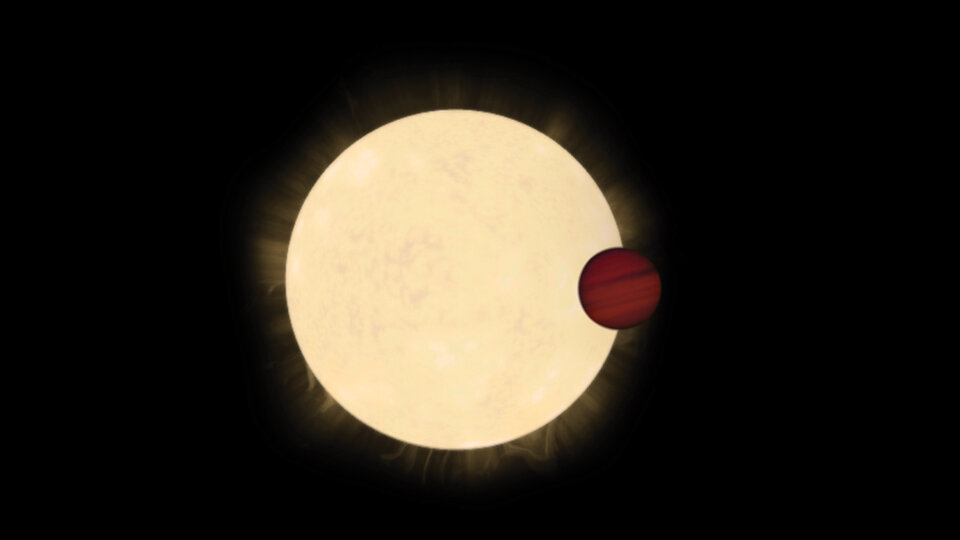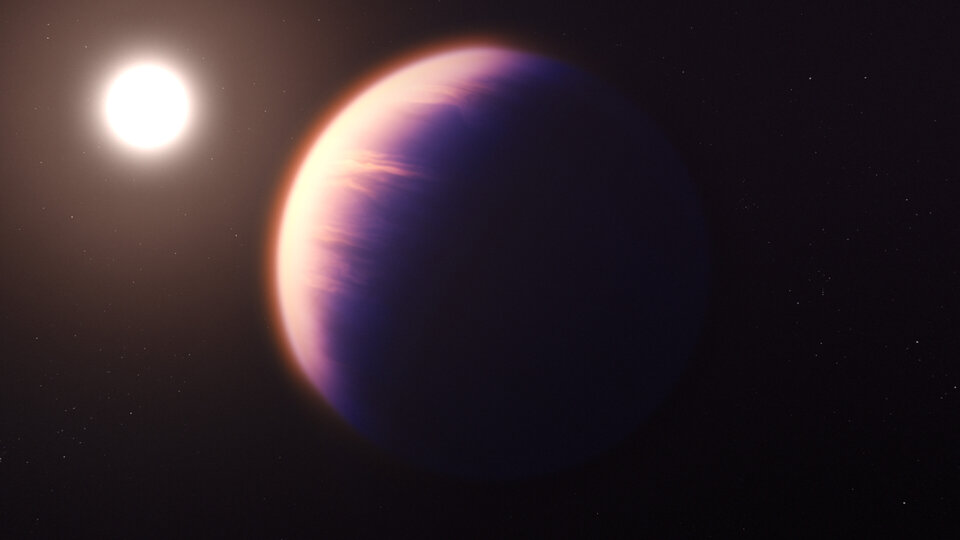Ariel's three key questions
ESA’s Ariel mission will shine a light on the extraordinary world of exoplanets. The satellite will study what the atmospheres of exoplanets are like and what they are made of. Ariel will also provide clues to the composition of the interiors of exoplanets and how planets form and evolve around their host stars.
1. What processes take place in exoplanet atmospheres?
Just like the planets in our Solar System, many exoplanets have atmospheres. Ariel will study a diverse sample of them to go beyond our first understandings of exoplanetary atmospheres.
Temperature
The temperature of an exoplanet varies throughout its atmosphere. How the temperature changes with altitude depends on the type of particles present. By studying temperature variations, Ariel will gather clues on atmospheric composition.
Many of the exoplanets that have been discovered so far are tidally locked to their host star. This means that they always show the same side to their star, just like the moon towards Earth. The dayside of these planets constantly receives heat and energy. The temperature on the nightside depends on the redistribution of that heat in the atmosphere. Ariel will study the temperature variations around planets and reveal what processes could explain them.

Chemistry
The exoplanets Ariel will observe are hot, all warmer than 200 °C. Many molecules in the atmosphere of such hot exoplanets will exist as a gas and we can detect them via spectroscopy: when exoplanets pass by their star, as seen from Earth, some of the starlight passes through their atmosphere and is absorbed by the molecules before reaching us. Ariel will detect and study the molecules’ signals in the light coming from them.
Clouds and haze
The wavelengths of light that Ariel will observe are ideal to study what the clouds on exoplanets are made of. The fingerprints of aerosols – tiny solid particles in the atmosphere – are prominent in infrared light. Ariel will be able to discover the size of individual particles and their distribution. These studies allow the mission to distinguish between Earth-like clouds and a chemical haze of solid particles.
2. What are the interiors of exoplanets like?

Earlier exoplanet missions such as ESA’s Cheops and Plato (due to launch in 2026) can provide accurate sizes for exoplanets. Together with mass measurements from ground-based observatories, this allows astronomers to calculate the overall density of an exoplanet. Ariel’s study of the temperature of a planet will help us interpret its mean density even better. Warmer air means the atmosphere expands and has a lower mean density. The density is important as it gives the first indication of what an exoplanet is made of: is it heavy and rocky or light and gaseous?
Ariel will measure the atmospheric composition of exoplanets. These measurements allow us to know what the outer layers are made of and estimate a planet’s density. The only mystery that remains is then what the core is made of; together, the density and composition of the atmosphere and the overall density constrain what the core is made of.
Some details about the composition of a planet’s core are already revealed by the composition of its atmosphere. Heavier elements belonging to the core are released into the atmosphere over time. This means that Ariel’s measurements of atmospheres will partially reveal what the cores of planets are made of.
3. How do planets and planetary systems form and evolve?
Giant planets
What a giant planet is made of depends on where it forms. By studying a large sample of planets Ariel will shine a light on this connection and help us understand how exoplanets migrate towards and away from their host stars. Some planets start forming in the outskirts of their systems and migrate inwards either during or just after their formation; currently it is thought that planets that form very far out – about 100 times the Earth-Sun distance – will attract matter as they migrate inward, changing their composition. Other planets form in place but later migrate due to interactions with neighbouring planets; they keep their original composition.

Super-Earths and mini-Neptunes
A curious case are the exoplanets bigger than Earth but smaller than Neptune, where Neptune is roughly four times larger than Earth. These exoplanets are often referred to as super-Earths or mini-Neptunes and they make up the transitional planets from small rocky bodies to large gaseous giants.
Past exoplanet missions such as NASA’s Kepler discovered that two families of these planets exist. The slightly larger family has a significant hydrogen-helium envelope whereas the slightly smaller family does not. Some intermediate-sized planets fall between these two families. It is not clear why these two families seem to exist, but Ariel will help us understand the nature of these planets through an in-depth study of their atmospheric composition, which will reveal their formation history.
Secondary atmospheres
Rocky planets form closer to their stars than the giants and mini-Neptunes mentioned above. During their formation they can develop atmospheres rich in hydrogen and helium, but magnetic activity from their stars can strip the planets of these atmospheres. Some of the rocky planets gain a secondary atmosphere over time due to volcanoes, the release of heavy elements from their core or asteroid impacts. Ariel will study the presence and composition of these secondary atmospheres and discover what the conditions are for a rocky planet to keep a significant secondary atmosphere.


